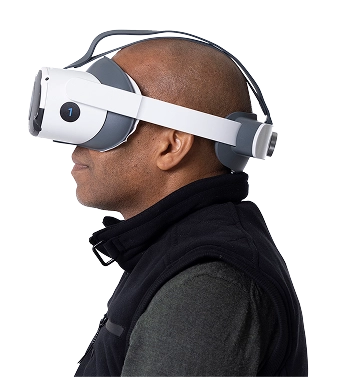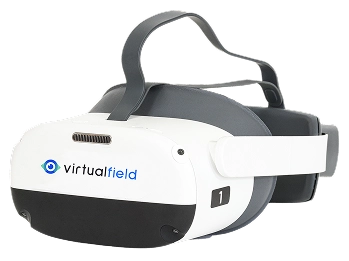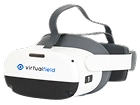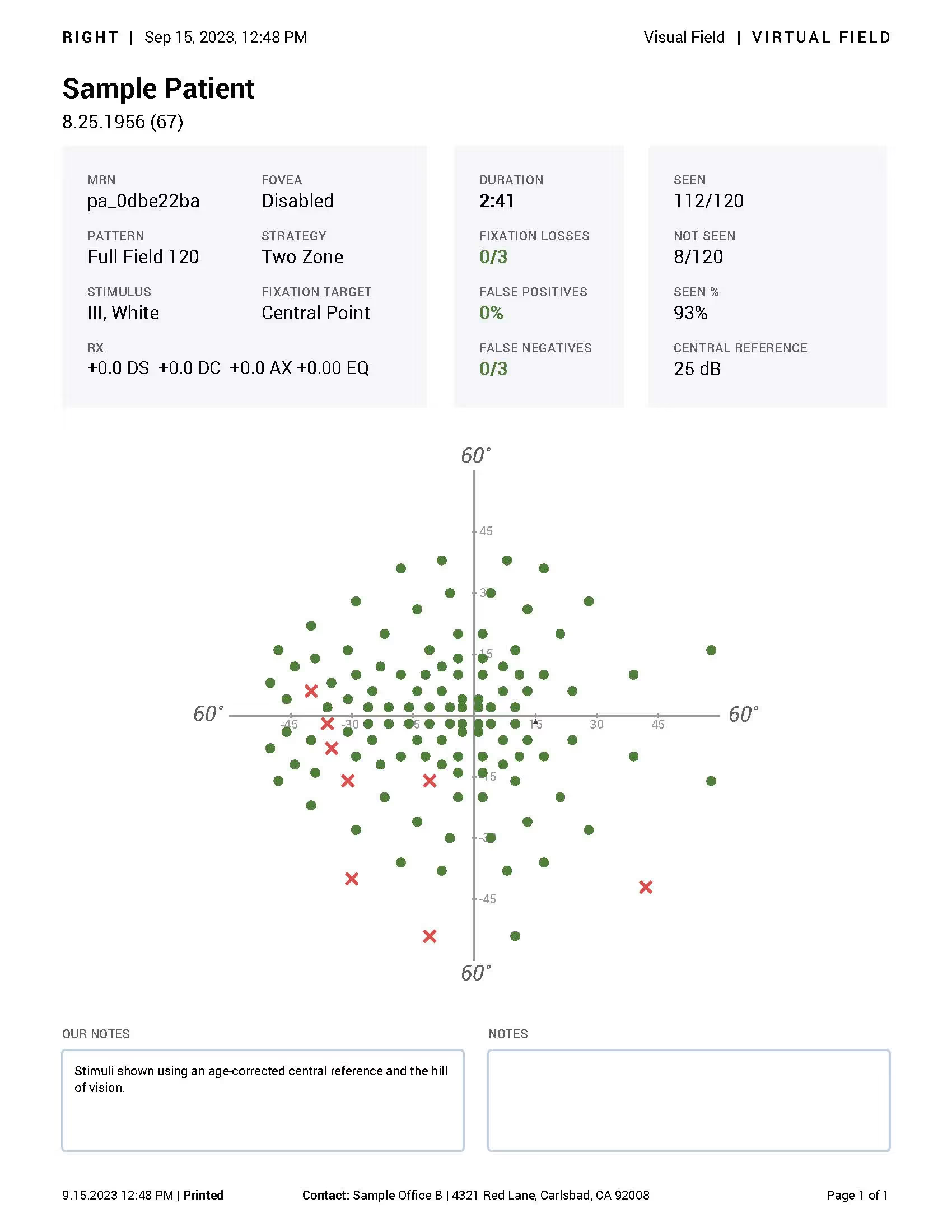As the name suggests, the Full Field 120 screening is a comprehensive assessment of a patient’s entire visual field. Other exams acutely focus on specific regions to collect details, but this test is more all-encompassing. With this broad range, you can identify common conditions like glaucoma, macular degeneration, or neurological conditions.
To make this test even more efficient and useful, Virtual Field’s wide‑field visual field device speeds up the process and collects accurate insights within moments. Offering more comfortable, accessible, and convenient Full Field 120 testing elevates the patient experience while supporting your practice’s workflow.
Full Field 120 Screening Overview – Using a Portable Wide‑Field Perimeter
For people with normal vision, each eye’s visual field spans 120 degrees horizontally and 90 degrees vertically. A peripheral visual field screener like the Virtual Field 120 test can pick up on the early signs of damage for faster intervention and more opportunity to preserve vision.
This test presents stimuli in both the central and peripheral vision areas and can be performed monocularly or binocularly to assess natural vision. The “120” refers to the number of data points collected from both eyes, each with an area 55 degrees from fixation. Conditions that cause optic nerve damage can create scotomas, and no matter where these scotomas appear, you can detect them using the Full Field 120 test. Because this visual field test has so many data points, it can take a little longer than others. Our portable wide‑field perimeter speeds up the process and offers a more patient‑friendly experience.
Bonus: The Virtual Field 120 test doubles as a rapid peripheral visual field screener for stroke, TBI, and drug‑toxicity work‑ups.
Academic references and clinical validation
The Full Field 120 is a suprathreshold exam, and this study showed that exams of this type perform well to screen for glaucoma.
Since the Full Field 120 test can collect so much data, it’s sometimes used to identify clinical indicators, such as drug toxicity.
Clinics that implement Virtual Field experience an average return on investment of 902%.
.avif)

30 days free.
No strings attached.
We are confident you’ll love Virtual Field just like the 2,000 doctors who have already made the switch.
The Full Field 120 Screening at a Glance – Wide‑Field, 120‑Point Coverage
Mapping 120 distinct points across the entire range of central and peripheral vision makes the Full Field 120 one of the most comprehensive tests available on Virtual Field. This wide coverage can help detect glaucoma, optic neuropathies, and visual pathway disorders that may not appear in central-only tests. But because it’s so comprehensive, this test has a longer duration than others. Patients who struggle with fatigue or attention may find this more challenging, but Virtual Field cuts testing time by up to 50%.
Pros and Cons of the Full Field 120 Test
The pros and cons that follow can help guide you toward the ideal scenarios to incorporate this test into your patients' diagnostic assessments.
Pros
Runs on a lightweight, portable wide‑field perimeter, no dark room needed.
Evaluation of both central and peripheral visual fields helps detect a wide range of defects.
This test is especially useful to diagnose early-stage glaucoma for faster intervention.
With 120 points, the visual field map is very detailed, so it’s good for follow-up and monitoring disease progression.
Virtual Field collects all these data points into our advanced algorithm for fast, precise insights.
Cons
Because it’s more comprehensive than others, interpreting Full Field 120 screening results can be complex and has a learning curve.
When using traditional tabletop perimeters, this test can take a long time and require specialized equipment for accurate results.
Although Virtual Field shortens the testing duration, this is still one of the longer exams, so patients who struggle to focus may become fatigued.
The Full Field 120 may identify minor defects that might not be relevant.
List of Ocular Diseases Monitored and Diagnoses Identified by the Full Field 120 Visual Field Exam
The Virtual Field 120 test helps diagnose or monitor:
Glaucoma
Peripheral vision loss is one of the first signs of glaucoma, and since the Full Field 120 examines the entire visual field, you can detect defects early.
Retinitis Pigmentosa
Retinitis pigmentosa is characterized by constricted peripheral vision and, ultimately, tunnel vision. Examining the entire visual field can reveal these changes earlier and help monitor progression.

60+
Macular Degeneration is the leading cause of vision loss in Americans aged 60 and older
2.5M
AMD affects 2.5 million Canadians
Stroke
Post-stroke patients may experience blind spots or larger visual field changes like hemianopia. The Full Field 120 can identify these spots and monitor changes following the neurological event.
Optic Neuritis
Inflammation of the optic nerve can result in central and peripheral visual field defects, which the Full Field 120 test can help identify.
Other Conditions
The Full Field 120 can also be used to monitor or diagnose:
- Pituitary tumors
- Multiple sclerosis
- Ischemic optic neuropathy
- Chiasmal syndromes
- Retinal detachment
- Traumatic brain injury (TBI)
- Peripheral visual field loss from medication toxicity – easily flagged by this peripheral visual field screener
Example Full Field 120 Report
30 days free.
No strings attached.
We are confident you’ll love Virtual Field just like the 2,000 doctors who have already made the switch.

Billing and Coding for the Full Field 120 Visual Field Exam
The Full Field 120 screening is an extended visual field exam, so it can be billed using CPT code 92083. Medicare Physician Fee Schedule (MPFS) reimbursement ranges from $25 to $81, and your fee will depend on practice location, setting, modifiers, and other factors.
When is the Full Field 120 test required?
This test is often enlightening for patients with symptoms that suggest peripheral vision loss, like difficulty seeing in low light, tunnel vision, trouble driving, or reduced depth perception. Patients with unexplained vision changes could benefit from a Full Field 120 test as a way to clear up their questions. People at risk of glaucoma, neurological disorders, or retinal diseases should have their complete field of vision examined at least once.
For patients with progressive conditions like glaucoma or retinitis pigmentosa, the Full Field 120 can monitor vision and inform treatment adjustments. Early detection allows for speedier intervention, so this exam is likely beneficial for a wide range of patients.
Is the Full Field 120 required for driver’s licenses?
The Full Field 120 exam, by name, isn’t mandated for driver's licenses, but its results often are. In most states, non-commercial drivers require uninterrupted vision of at least 100 degrees horizontally, using both eyes. The Full Field 120 can clearly identify this range, so the results from this exam are highly relevant for drivers.
To gain a commercial driver’s license (CDL), drivers require a horizontal field of vision of 70 degrees in each eye. That aligns perfectly with the Full Field 120’s capabilities. Although states rarely specify the name of the visual field exam needed for driver’s licensing, the Full Field 120’s results support these requirements for eligible drivers.
Start Conducting the Virtual Field 120 Test on a Portable Wide‑Field Perimeter
When patients present with unknown visual field changes or risk factors for glaucoma, it’s worth setting aside a few extra minutes to conduct the Full Field 120. With this test, you can reveal a wide range of conditions and gain a comprehensive perspective on patients’ vision. And by conducting these exams using Virtual Field, you can expedite and streamline the testing process without sacrificing the patient experience. When patients present with unknown visual field changes or risk factors for glaucoma, it’s worth setting aside a few extra minutes to conduct a Full Field 120 screening.
Want all 23 exam guides in one place?
Download our comprehensive guide for 160+ pages of insights.
FAQs
1. How wide does the Full Field 120 pattern extend?
2. What is the Ideal clinical use for Full Field 120?
3. Which CPT code is best for the Full Field 120 visual field test?
4. How long is the typical duration of a Full Field 120 visual field test?
5. Can I monitor peripheral constriction over time?
6. Does the headset accommodate spectacles?
Ready to get started?
Schedule a demo or begin your 30-day free trial of Virtual Field to try our EOM exam in your practice.

Questions? Contact sales@virtualfield.io talk to a Virtual Field expert today.



